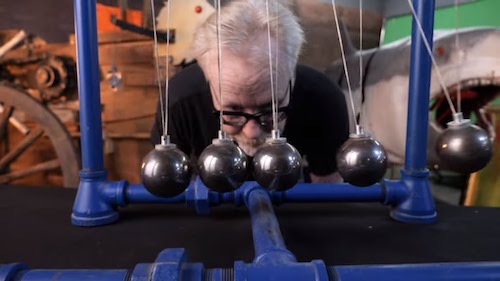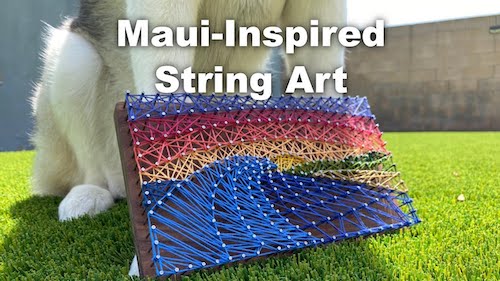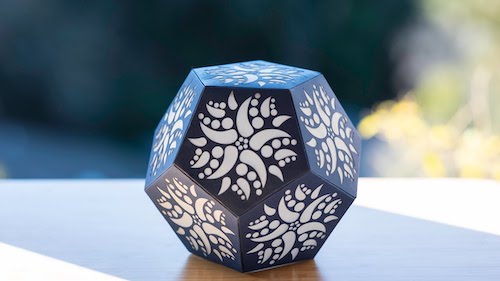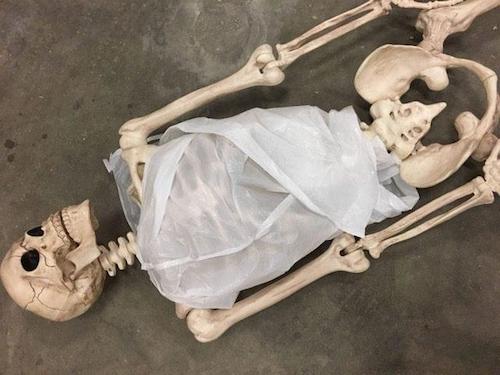Howl’s Moving Crafting Hoard [Maker Update]
This week on Maker Update, from garbage to Ghibli, cyborg William Tell, riding the last mile on your butt, book bundles, string art, and pool noodle robot whegs.
++Show Notes [Maker Update Ep. 246]++
-=Project of the Week=-

Howl’s Moving Castle made from Trash by Studson Studio
https://www.youtube.com/watch?v=FDQ-sDDqWvk
-=News=-

3d Printed Textile that Automatically stiffens under force
https://hackaday.com/2021/08/15/3d-printed-fabric-stiffens-on-demand/

Grant Imahara Steam Foundation Auction
https://propstore.com/mythbusters-gallery/
-=More Projects=-

Robot Archery by Stuff Made Here
https://www.youtube.com/watch?v=1MkrNVic7pw

The Boot Scoot by Ruby Zoom
https://www.youtube.com/watch?v=a_1ir6Wu7p4

CNC String Art by Winston Moy
https://www.youtube.com/watch?v=jWjcSuBXg2s
-=Tips & Tools=-

Cuttle.xyz is out of early access
https://cuttle.xyz/dashboard

Back to School Book Bundle by Make Magazine & Humble Bundle
https://www.humblebundle.com/books/back-to-school-make-books

Pool Noodle Whegs for Amphibious Robots
https://www.instructables.com/Amphibious-Robots-Using-Pool-Noodle-Wheels/

Decomposing Skeleton Prop by TheEscapeEffect
https://www.instructables.com/Escape-Room-Props-Decomposing-Skeleton/
-=Digi-Key Spotlight=-

How to Solder QFN Packages by Shawn Hymel
https://www.youtube.com/watch?v=X3Rc1s6EpSI
Transcript
This Week on Maker Update: From Garbage to Ghibli, Cyborg William Tell, Riding theLast Mile on your Butt, Book Bundles, String Art, and Pool Noodle Robot Whegs.
Hello and welcome back to Maker Update! I’m Tyler Winegarner and I hope you’re doing great, whether you’re getting ready to get back to school, or just enjoying the midpoint of summer. We’ve got another great show for you so let’s check out the project of the week.
Making a model of Howl’s Moving Castle from… Howl’s Moving Castle is a daunting enough task on its own. But making it entirely out of salvaged containers, scrap material and anything else you happen to have lying takes a special kind of way of looking at garbage. Good thing that Studson Studio is showing us their lens on litter so we can learn their ways.
Ok, so this is a really long video. It clocks in at almost an hour but you’ll be surprised at how compellingly it moves along. The video begins by making the base structures for the castle, and most of it is from discarded food containers. The main base is from a gallon kimchi jar, and a lot of the other structures are made from chopped up bits of plastic nut jars because they have a ton of complex, interesting curves.
From there, he just kind of gets stuck in on the details. Overlapping metal sheets are made from sections of takeout containers. Boards and shingles are made of coffee stirrers, pipes made from plastic saxophones, and custom buildings made from sculpting foam. One of my favorites is all of the rivets that cover the structure, which before the final paintjob you can tell are made from tiny rhinestones.
This entire video is a king’s ransom in crafting tips. I love the look of these foam bricks after they’ve been distressed by shaking them in a jar full of rocks – or getting inches of tubing for pipes and handles from anything round and plastic. I don’t really want to encourage anyone to begin a hobby of hoarding garbage, but this video is a masterclass in kitbashing, and a compelling watch.
Time for some news, researchers in Singapore and at CalTech have developed a 3d printed fabric with some properties you wouldn’t expect from a 3d printed from. Made from interlocking octohedrons, it flows well enough on its own. But when sealed up in a vacuum bag, it stiffens pretty significantly once the air is drawn out, using what’s known as a “jamming transition”.
Under vacuum, it’s supposed to be able to support over 50 times its own weight. In the video they show a few of the practical allocations for this, like building rigid structures, or helping a wearer carry heavy loads. There’s definitely a couple of challenges to make this work to protect against impacts, like how you draw the air out fast enough, but there’s some cool exploration to be done here.
Through Tested I learned about the Grant Imahara Steam Foundation. That’s not exactly new information, but what is news is the upcoming auction of Mythbusters Memorabilia held by The Prop Store, and all of the proceeds from the auction are going straight to the foundation. You might have seen some of the stuff already in a series of videos hosted by Adam Savage, and these alone are worth the price of admission, just for the commentary – but the opportunity to have any of these in your home would be a rare treat indeed. The auction will be run online from August 20 through September 1st.
More Projects! Shane from Stuff made Here is continuing his transition into some sort of rube-goldberg Q from the James Bond series. In a recent video he’s made an archery bow that can automatically hit stationary and moving targets. It can also make him punch himself in the face. Like… a lot.
The system is made of three components. The bow is held by an armature that can adjust its spacing to correct for his poor aim. Instead of holding the bowstring in his right hand, he holds a mechanism that releases the string for him. The last part of the recipe is a series of tracking cameras that track the position of the target, the bow and the string puller. This is a fun video about problem solving – and with a problem this complex, there’s a lot to solve for.
On the r/maker subreddit I learned about the Boot Scoot 3004 by Ruby Zoom, which is sort of cautionary tale about what happens when you make a fiberglass mold of your butt, and ask the internet “what next?”
After attaching the wheels from a motorized skateboard to it, she’s either created the most unstable skateboard, or the last-mile vehicle that people are most likely going to want to have a conversation with you about. This is a really fun project from an emerging channel, and it’ll be fun to see where she goes with it.
And finally, Winston Moy, master of the hobby CNC router is taking on a project that’s a little outside of his wheelhouse: string art. He admits up front that creating digital art is not his forte, but he wanted to challenge himself to make a unique gift for his partner. After struggling with the design of the artwork, he used Fusion to create toolpaths for all of the drill holes for the nails, and the outer shape of the board. And then he laid out the string colors for the design.
Its great to see skilled folks like Winston express himself in new creative ways, but the CNC Router also makes for a powerful tool in creating consistent designs and hole depths that make the final product really shine.
Time for some tips and tools, a few months ago Donald introduced us to Cuttle, which is a web-based design tool that can work with any kind of digital cutting machine. Back then it was in a closed Beta, but now it seems like its open for everyone to use. If you missed it, Cuttle is a shockingly powerful design tool, allowing you to incorporate parametric elements, repeated designs, boolean tools and plenty more. There’s a handful of tutorial videos to get you started, and a discord server to help you find the community of cuttle users.
Over on Humble Bundle, Make Magazine has organized a back-to-school-themed collection of digital books for Makers. What’s best is that you can name your own price to get access to the entire collection. There’s some real bangers in here too, like Props and Costume Armor by Shawn Throsson, Musical Inventions by Kathy Ceceri, Fusion 360 for makers, The Maker Magicians Handbook by Mario Marchese, and plenty more. The bundle is running for another week and a half, so don’t sleep on this one.
On instructables I found this great tip from Wadevag for building amphibious robots. By making the wheels for your bot out of segments of these star shaped pool noodles, they not only get great traction on dry land, but can also float on the water, and the star shape works like a paddle wheel. Through this video I also learned that the technical term for this kind of wheel is a “wheg” which is a portmanteau of Wheel, and Leg. It’s cool stuff.
And finally, delta variant be damned, I hope folks are starting to think about halloween decorations, even just to make their homes and private gatherings a little more spooky. I found this great tutorial by TheEscapeEffect on how to turn a normal prop skeleton into a creepy, decomposing one. The technique looks simple enough, just take your skeleton and wrap it in plastic trash bags. You then use a heat gun to melt the bags to the skeleton and blow holes in it, and then finish it with some wood stain. It’s a convincing effect, and a great – if gross looking – result.
For this week’s Digikey Spotlight we’ve got a great tutorial from Shawn Hymel on using a hot air station for soldering QFN package components. I’m sure you all know that with a steady hand and some clever soldering techniques you can do surface mount components with a soldering iron, but what if your component has solder pads underneath the package? QFN stands for Quad Flat / No Leads and refers to a component with no exposed solder leads.
There’s a great walkthrough here on getting the right temperature and air velocity of your hot air nozzle, the best types of solder and flux to use, and the actual technique of getting your solder up to temperature. I’m still cozy in my world of through hole components, but if you’re ready to step up to surface mount, this is a great resource.
Alright, and that is going to do it for this week’s show. Thank you so much for watching. I don’t know about you but I can’t wait for my next trip to the thrift or dollar store to see how old shapes can be transformed into new designs. I hope you’re looking forward to the same. If you enjoyed this show, give us a thumbs up, hit subscribe, leave us a comment about your favorite piece of salvage. Huge thanks as always to our pals at Digikey for making this whole show possible! Take care, and I’ll see you soon.


![Tabletop Turing Machine [Maker Update]](https://i0.wp.com/www.makerprojectlab.com/wp-content/uploads/2025/04/MU429_thumb_16x9.jpg?resize=150%2C150&ssl=1)
![Something Old, Something New [Maker Update]](https://i0.wp.com/www.makerprojectlab.com/wp-content/uploads/2025/04/MU428_thumb_16x9.jpg?resize=150%2C150&ssl=1)
![Positive Feedback [Maker Update]](https://i0.wp.com/www.makerprojectlab.com/wp-content/uploads/2025/04/MU427_thumb_16x9.jpg?resize=150%2C150&ssl=1)
![The Future’s So Bright [Maker Update]](https://i0.wp.com/www.makerprojectlab.com/wp-content/uploads/2025/03/MU426_thumb_16x9.jpg?resize=150%2C150&ssl=1)
![Keys to Success [Maker Update]](https://i0.wp.com/www.makerprojectlab.com/wp-content/uploads/2025/03/MU425_thumb_16x9.jpg?resize=150%2C150&ssl=1)
Submit a comment